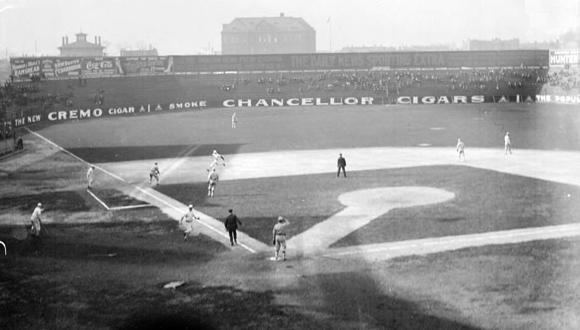Capacity 15,000 Opened 1890 Demolished 1940 | Broke ground 1890 Closed 1940 | |
 | ||
Location West 38th Place & South Princeton Avenue, Chicago, Illinois 60609 | ||
South Side Park was the name used for three different baseball parks that formerly stood in Chicago, Illinois, at different times, and whose sites were all just a few blocks away from each other.
Contents
South Side Park I (1884)
The first South Side Park was the home of the short-lived Chicago Unions entry in the Union Association of 1884. Newspapers gave its location as "the corner of 39th Street and South Wabash Avenue", not specifying which corner.
The venue was also called Union Base Ball Park and 39th Street Grounds in local newspapers. A late-winter report on "improvements" to the 39th Street Grounds indicates the site had already been used as an amateur ball field.
The Unions played 35 games at this park between May 2 and August 1.[1] The papers indicated they were then headed on a three-week road trip. After that road trip, they re-emerged as the Pittsburgh entry, which played five home games at Exposition Park before taking to the road for the last few weeks of their existence.[2]
South Side Park II (1890–1893)
The second South Side Park was first the home of the Chicago Pirates entry in the Players' League of 1890 (whose roster included Charles Comiskey), and then was the home of the National League club now called the Chicago Cubs during parts of 1891–1893. In 1890, it was usually called Brotherhood Park in the local newspapers, as with several of the Players' League venues.
The park's location was typically given as 35th and Wentworth, which was the location of the main entrance, and convenient to an east-west rail line.
The field generally occupied the same footprint as the future Comiskey Park along with Armour Square Park. The Chicago Tribune, in an article on January 19, 1890, stated that the property was bounded by 33rd and 35th Streets to the north and south, and by Wentworth Avenue and the Rock Island Railroad to the east and west respectively. The article said the grandstand would be built along 35th Street. However, another article exactly one month later stated that the grandstand was being built on the 33rd Street side of the block, to hold 4,000 patrons, and additional "bleaching boards" seating to accommodate another 3,000.
The League club acquired the lease on the grounds after Comiskey's team and the league folded. They played a partial schedule at this field in 1891, continuing to play other games at West Side Park (I) during 1891.[3] They then played their complete home season on the South Side in 1892.
When the World's Columbian Exposition opened in 1893, the League club wanted to break with their no-Sundays tradition and start playing Sunday games to attract Fair visitors, but their South Side lease forbade Sunday ball. They sought a new location, which turned out to be West Side Park (II). After drawing well on their first few Sundays, the club abandoned the South Side park and moved to the West Side on a full-time basis.
The south end of the property was site of Comiskey Park from 1910 through 1990, and is now a parking lot for the current Sox ballpark. Armour Square Park was established in 1905 and still has ball fields on it.
South Side Park III (1900-40)
The third South Side Park, the best known and longest lived venue by that name, was on the north side of 39th Street (now called Pershing Road) between South Wentworth Avenue and South Princeton Avenue, located at 41°49′28″N 87°37′58″W. The 39th Street Grounds served as the playing field of the Chicago Wanderers cricket team during the 1893 World's Fair. After Charles Comiskey built a wooden grandstand on the site in 1900, it became the home of the Chicago White Sox of the American League. It served as home to the White Sox first in 1900 as a minor league team, and then from 1901 to June 27, 1910 as a major league team.
The team abandoned the wooden ballpark, with its capacity of 15,000, in the middle of the 1910 season after their new steel-and-concrete, and much larger Comiskey Park was finished, just three blocks north of the old park (corner to corner), where they began an 80 1⁄2 season run. Meanwhile, South Side Park became the home of the newly formed Negro League baseball team called the Chicago American Giants in 1911. It was renamed Schorling's Park for team owner Rube Foster's white business partner, John C. Schorling, a south side saloon keeper who leased the grounds and happened to be Comiskey's son-in-law.
The American Giants played their games there through the 1940 season. Then on Christmas Day of 1940, Schorling's Park was destroyed by fire. The American Giants would play their remaining 10 seasons at Comiskey Park. Today, the Chicago Housing Authority's Wentworth Gardens housing project occupies the site.
The South Side Park/Schorling's Park/Wentworth Gardens site is located across Pershing Road from a junkyard site which was named a Superfund site in the late 1990s.
World Series
It was the site of baseball's first crosstown world series in 1906. The Chicago White Sox defeated their crosstown rival Chicago Cubs in 6 games to clinch the title at home with an 8-3 victory to capture their first World Series title.
Negro National League Championships
It was the home for the Negro National League(NNL) champion Chicago American Giants in 1920, 1921, 1922, 1926, and 1927.
Negro Southern League Championship
In 1932, the Cole's American Giants won the Negro Southern League pennant.
